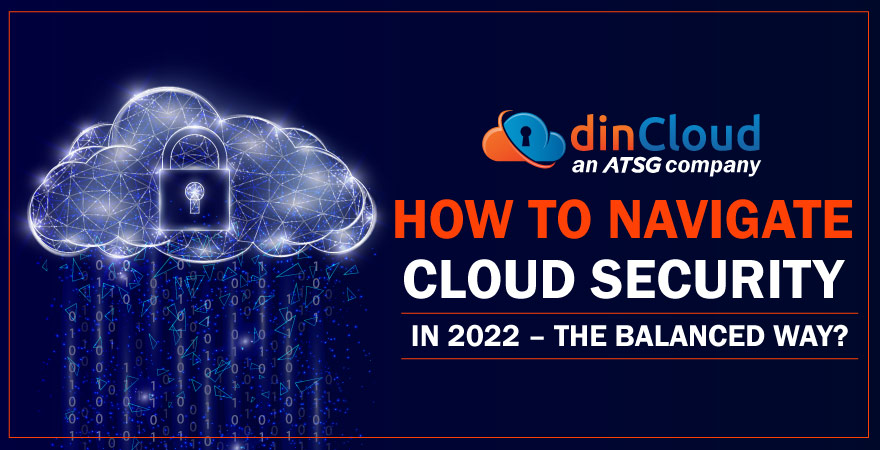With every passing day, the urgency for enterprises to adopt flexible and agile cloud infrastructures is rising. This on-going cloud revolution was only accelerated with the full onset of a pandemic of global proportions and worldwide disruptions.
When it comes to adopting cloud infrastructures, the first thing that pops up in the heads of most Chief Information Officers (CIO) and Chief Information Security Officers (CISO) is Cloud Security. In some cases, security related concerns might deter a migration altogether.

While such concerns are also not completely ill-founded, an overly cautious approach can also spell problems for a business that wants to retain a mainstream status. In this post, we will address the question of managing cloud security in a well balanced way.
Related: A Recap of Cloud Trends in Year 2021, and the Outlook for 2022
The Risk Opportunity Debate
In the present technology and business environment, adopting Cloud Computing solutions and integrating them with business processes is becoming very crucial. The common perception is that opening a business to the Cloud will also open up new risks.
On the flip side, without adopting flexible and agile Cloud Computing solutions, a business stands to lose a lot of growth opportunities. While a business may not be impacted much by missing just one such opportunity, but shying away from opportunities is not good.
So, the path to availing today’s business opportunities, with manageable levels of risks, comes by adopting a balanced approach. This approach in fact involves striking a middle ground between the various opportunities, while managing the associated risks.
Related: Cloud Computing, Cyber Security and Artificial Intelligence in 2022
The Misperception about Cloud Security
Another very important aspect of this whole discussion is the general misperception that exists about cloud infrastructures. The common view, which is ill founded, is that cloud solutions and infrastructures tend to be less secure.
On premise IT infrastructures, on the other hand, are perceived as more secure as compared to Cloud Computing solutions. This is quite far from the truth, as neither the cloud, nor the on-premise IT infrastructures are inherently secure.
It is basically how an enterprise plans and executes security protocols that will truly make the difference between a secure and insecure IT environment. With this issue out of the way, let us discuss the weaknesses of cloud deployments in an objective manner.
Distinguishing Misconfigurations from Security Weaknesses
Upon critical and in-depth analysis of the security breaches associated with cloud infrastructures, you will realize that most of these security breaches were the outcome of misconfigurations, rather than any inherent weaknesses within cloud environments.
A security breach over the Cloud, which occurs due to a misconfiguration, should never be considered as a lapse on the part of the Cloud Service Provider (CSP). This unfortunately has consistently been the case, when it comes to CSPs.
Related: Zero Trust – An Emerging Challenge for the Government and Private Sector
Implementing the Shared Responsibility Model
The perfect starting point when navigating cloud security is thorough implementation of the Shared Responsibility Model. Under this model, the Cloud Service Provider (CSP) and the deploying enterprise are jointly responsible for securing the entire ecosystem.
However, the domains of both the CSP and the deploying entity are quite different. The CSP is primarily responsible for securing its own cloud infrastructure. Other aspects like access management, configuration and application level security do not fall in the CSP’s scope.
Instead, these facets of the cloud infrastructure are the responsibility of the enterprise that deploys the cloud solution in the first place. Once these non-overlapping, yet extremely important domains are addressed as a whole, only then can you achieve a secure cloud.
Constant Evaluation for Gaps in Security
An enterprise can be given due allowance if it takes the plea that it transitioned over to the Cloud on a very short notice. The most recent and relevant example of that is the Covid-19 pandemic, which induced a fast track “exodus” of enterprises to Cloud infrastructures.
However, once the migration has taken place and the “storm has passed”, that would be the right time to sit on the drawing board and thoroughly evaluate the whole ecosystem for gaps and vulnerabilities.
Related: The Evolution of Cloud Gaming in the Year 2022; and Beyond
Lastly, it is very important that such “security audits” should not be a one time thing. Instead, this should be a recurring practice, especially in today’s volatile conditions. As soon as gaps in security are identified, they need to be plugged at every cost.
Conclusion
It would be unjustified to hold Cloud Service Providers (CSP) accountable for something they have not done in the first place. If at all, CSPs have been nothing short of a true lifesaver for thousands of enterprises globally by delivering Business Continuity (BC).
Related: Companies like BAE Systems Brace for the Hybrid Multicloud
Cyber security is something that needs to be engrained in the very fabric of an enterprise. It comprises a mindset, which needs to be exercised by every member of the organization, regardless of the individual’s position or job role.
Contact dinCloud, an ATSG company, for high performance cloud solutions that come with a multi layered security built into the very service.


